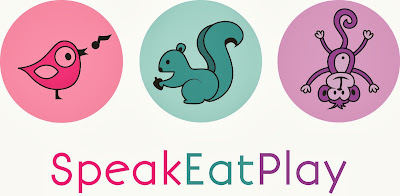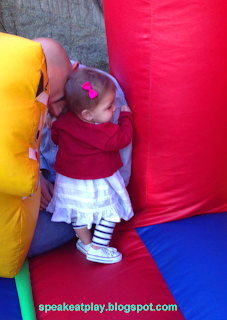Q: Will learning two languages cause speech or language impairments?
A: No. This is a big misconception and myth. It is counterintuitive as one may think bombarding the system with two languages will cause a delay. However, there is no research to support this. There is no research that shows that hearing or learning more than one language will impair you or delay you. If a child has a true language learning delay, this delay will manifest itself in both languages. Millions of people worldwide have learned multiple languages without acquiring a delay or language impairment. Even children diagnosed with language impairment are capable of acquiring more than one language. Research has shown that bilinguals with diagnosed language impairment actually do better in the long run than their monolingual counterparts.
* Bilingual children with language impairments showed commensurate language skills to monolinguals with language impairments (Paradis, 2005).
* Bilingual children with language impairments exhibited same type and frequency of grammatical errors as monolinguals with language impairments (Paradis,Crago, Genesee, & Rice, 2003).
* Bilingual children with Down Syndrome (DS) showed commensurate language skills to monolingual children with DS (Kay-Raining Bird, Cleave, Trudeau,Thordardottir, Sutton, & Thorpe, 2005).
* 5 year study of bilinguals at Cornell Language AcquisitionLab revealed that learning a second language does not have any negative effect on a child’s cognitive ability.
Q: Are there any benefits to being bilingual?
A: Many! It promotes mental agility and helps delay neurological disorders like dementia and Alzheimer Disease.Research has consistently shown that bilingual children typically have improved working memory (WM) and executive functioning abilities. The enhanced ability to process sounds, another benefit of being bilingual, is a big advantage with regards to language acquisition. According to the American Psychiatric Association, bilinguals can actually pay attention better. This combined with the optimized brain capacity and increased concentration through the neuroplastic workout really lends itself to learning better in general. In addition, bilinguals have more career opportunities than monolinguals.
Q: My child is speaking “Spanglish” or mixing both languages.I’m concerned that he may be getting confused? What do I do?
A: Let us first discuss what is “Spanglish” or better known as Code Switching. “Code-switching is a verbal skill requiring a large degree of linguistic competence in more than one language, rather than a defect arising from insufficient knowledge of one or the other… Rather than presenting deviant behavior, [it] is actually a suggestive indicator of degree of bilingual competence.” (François Grosjean) Why do we do this? Well there are various reasons why. Code-switching, is a sign of mastery of two linguistic systems, not a sign of language confusion. Children as young as 2 years old are able to code-switch in socially appropriate ways (Lanza, 1992). Sometimes the other language has a better word or phrase to express a particular idea. Sometimes the words we code-switch are the only ones we have, or they are more readily available in the other language. Occasionally, we code-switch as a communicative tool, including to exclude someone or to show expertise. Children are products of their environments. If they are constantly hearing “Spanglish,” then they will pick it up. It is, however, natural for them to mix them as they are acquiring both and make errors such as “the house red” instead of “the red house.” It is important to remember that in terms of raising bilingual children, the experts agree that while they’re learning both languages, it is better if they’re exposed to each of them in a monolingual setting. In other words, children learn by example, so the less mixing you do, the less mixing they’ll do—at least until they become proficient in both languages.
Q: My child has a language delay. Should I use only one language when speaking to him?
A: Many people, even professionals, believe that reducing to one language in the home will improve your child’s chance for success, however, this may have a negative impact on the child. This may cause a social emotional impact for child and family as it will result in reduced capacity and quality of communication with the family. For example, if a parent only speaks Spanish but the child is delayed in school and a professional told the parents to only speak to the child in English, how would that parent be able to communicate with the child? Also, if the parent is not proficient in that language what type of example are they setting for that child? Communicating in the language they speak best offers rich language and grammatical models. Moreover, reducing to one language may negatively impact the child, decreaseself-esteem, and decreasing identity with community and culture.
Q:5. Can I hire a speech therapist to teach English to my child?
A: No, that is the role of an English teacher or ESOL teacher. Alicensed Speech-Language Pathologist should only treat children with a diagnosed speech and language impairment in that specific language. Let’s say I evaluate a child in both English and Spanish. Results from that evaluation revealed that the child tested within normal limits in Spanish and was delayed in English. Would they have a true language delay requiring speech therapy? Absolutely not. Remember this. A true language delay will manifest itself in both languages. That is why it is important to look at the bilingual child’s both languages to determine if there is true language impairment or if they “appear” to be delayed secondary to second language acquisition.
How to foster a bilingual Environment:
* Key ingredients: input ,exposure and consistency no osmosis here
* Unrealistic to expect your child to learn Spanish by watching countless hours of “Dora The Explorer”
* Children will develop a language if they feel they need it
* If you create the need for more than one language the children will become bilingual
* Make it a natural and unremarkable part of life
References and more information/links:
Jennifer Rodriguez, M.A., CCC-SLP, has been a bilingual speech-language pathologist at Miami Children’s Hospital-main campus over the past 6 years. She received her Master’s degree in Speech-Language Pathology at Temple University and was dually enrolled in the Bilingual Emphasis Program. Moreover, she has been published in the American Journal of Speech Language Pathology and has been active in the bilingual community by providing in-services, attending bilingual symposium conferences, and demonstrating best practices in assessment and treatment of bilingual populations.

















